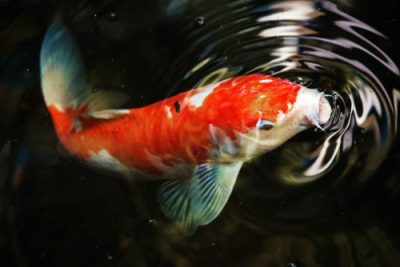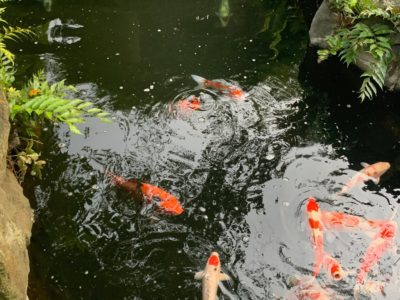The symbol of longevity and strength in Japan, Koi fish are popular fish to keep in Japan and the rest of the world. Their calming beauty has fans all over the world and breeding this type of carp became a large business. Where did koi fish originate and what is the significance of their patterns. Moreover, where can you see these wonderful water dwellers when you travel to Japan?

Origins of Koi Fish
While koi fish are always associated with Japan, the carp actually originated in China and is not native to Japan. The original carp is dark brown/black, you can still see this type of carp everywhere today. This carp was brought to Japan by the Chinese over 2000 years ago. Since then, it was the Japanese that started breeding these carp with regards to their color from around 1800. This is how new patterns slowly started to emerge.
It was the rice farmers who were keeping koi in their rice fields that did this by breeding the individuals that had naturally occurring mutations. The first type of new coloring was a carp with a red belly, and from here other types were newly ‘created‘.
White carp with red spots eventually became the most popular subtype. The pinnacle of great breeding is the completely white fish with a round red dot in the middle of its forehead. Its pattern is making it look like the Japanese flag! This type is called Tancho after the crane that has a red spot on its head, and it can cost tens of thousands of dollars. It can cost even more in the rare cases when the fish turns out perfect, meaning it doesn’t have any other colors or spots beside the red dot. Additionally, the dot has to be at a perfect location on top of the head.
Life of a Koi Carp
The optimal breeding temperature for koi carps is when the water temperature is around 20 degrees Celcius (68 degrees Fahrenheit). This means that koi will usually spawn in May or June. At the beginning of life, things are hard in natural circumstances. When they mate, koi fish also eat their freshly hatched young. This is why if they are being bred, the breeder will remove adult fish once the eggs have been fertilized.
If a young fish makes it through the first few months, they usually grow up to around 90 centimeters. This only happens if the circumstances are good. This means that they have enough space, food, and favorable temperatures. Koi carps are not active throughout the year, as they go into a hibernation of sorts during wintertime. They will usually look for a quiet, safe place under a bridge or
It is not surprising that the koi fish became a symbol of longevity, as the oldest carp on record became a whopping 226 years old. This achievement is claimed by a fish called Hanako, who lived until 1977. This was quite an abnormality though, as most koi live until around age 35, which is still quite old for a fish. You can’t really tell how old a koi fish is by just looking at it. Actually, the fish’ age is only determinable by microscope if you look at growth marks on the scales.
Color Patterns
There are hundreds of different koi varieties, some of the more common ones are the Asagi koi (silver color with a net pattern with red spots) and Kohaku koi (white and red patterning). Showa koi (similar to Kohaku koi with additional black spots), butterfly koi (with beautiful long fins), and the famous Tancho (the fish with a red dot on their head) are also popular.
The coloring of the fish stands for different symbolism, which is an important feature of koi fish in Japan. Gold-colored koi are obviously associated with wealth. Silver-colored fish are associated with business success, blue carps bring peace and quiet. The colorful koi of the Asagi type that are blue, red, and grey stand for positivity.
Koi Fish in Japan
So where do you need to go to see the beautiful creatures in their natural habitat in Japan? Luckily, this is very easy as larger temples and shrines often have koi ponds on their grounds. There are also many Japanese landscape gardens all over the country that more often than not boast an impressive koi pond. Even some Japanese-style hotels and ryokan have gardens that contain koi ponds. Here are some of the best spots to see koi ponds in Tokyo;
- Happo-en in Shirokanedai
- Gajoen in Meguro
- Sensoji temple in Asakusa
- Yasukuni Shrine in Kudanshita
- Ikedayama Park in Gotanda
Beautiful Shimabara
Another special place to see koi fish would be Shimabara near Nagasaki. This town is located in Kyushu, which means it is a bit far away from Tokyo. Kyoto is closer, but it will still be a 5-hour+ trip to get there meaning this is a place to visit if you are already going to Kyushu anyway. If you make it there, it will be a fantastic place for koi lovers and those who like spots of interest in general.
Shimabara is also called a ‘City of Water’ because there are over 60 spots in the city where water flows from natural springs. It then flows into small ponds and narrow waterways on the side of the street. And you guessed it, there are many koi fish swimming in these waters all over the city. It is an especially nice place to visit in the warmer summer months when you can enjoy a drink in a shaded place surrounded by water and fish to cool you down.
If you want to go one step further and visit a koi farm, it is not easy to arrange it by yourself unless you have connections or speak Japanese. If you need help with arranging a koi farm visit, please contact us for more information.
Your Japan Tour
As seasoned Japan experts, we can help you create your perfect Japan tour including destinations where you can see koi fish and custom-built tours that include a visit to a koi farm. Contact us to start planning your unforgettable holiday to this fascinating country. Japan is full of once-in-a-lifetime experiences, culture, history, nature, and delicious food!

